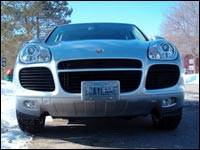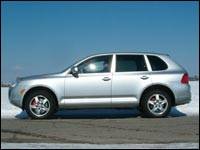Stop reading this right now if you are either: a) A fully-carded member of the Green Party; b) an overzealous brand guru; or c) the owner of a snappy tweed cap and string back gloves combo who's still pissed at Porsche for the 928.
For the rest of us, the Cayenne, Porsche's first sport-utility-vehicle, has merely been considered the black sheep of the sports car herd from Stuttgart.
Looking back to 1998, when the decision to build a Porsche SUV was taken, Porsche product planners had their sights on two targets: BMW's X5 and the Land Rover Range Rover. According to those planners in Zuffenhausen, neither combined superior performance on-, or off-road, and both were positioned at opposite ends of the SUV market. Despite sharing the development with Volkswagen, everyone at Porsche will tell you that there have been no engineering compromises with the Cayenne. The beast had to pass the same endurance and performance testing that any of the German maker's sports cars are tested with.
Porsche's translation: The Cayenne is a true Porsche.
That's the company line, anyway. But how can an SUV that weighs over 2,300 kilograms demonstrate Porsche's legendary driving dynamics? The top-of-the-line Cayenne Turbo ($125,650) I'm driving has, on paper at least, the numbers to substantiate such seemingly lofty ambitions.
The Cayenne Turbo's 4.5-litre, twin-turbo vee-eight, with its 450 horsepower and 459 lb ft of torque, betters the BMW X5 4.8is' ($96,500) power numbers by 95 and 90 respectively. And the Range Rover HSE ($99,400)? Its 282 horsepower and 325 lb ft of torque are left well behind. The non-blown version of the Porsche vee-eight found in the mid-range Cayenne S is more inline with these original marketing targets with 340 horsepower and 310 lb ft of torque, and in this rarefied price range, its a relative bargain at $78,800.
Applying the Cayenne Turbo's prodigious might to the road is a mandatory six-speed Tiptronic automatic transmission with Porsche Traction Management (PTM) four-wheel drive system. (If you want to heel-and-toe in a Porsche SUV, there's always the base model Cayenne with the Volkswagen vee-six and six-speed manual.)
The Tiptronic tranny endlessly adjusts its shift points to suit my driving whims, but in the Cayenne there's also a hill recognition mode where the transmission holds onto a low gear on long uphill and downhill slopes. In dry conditions PTM decides on a front-to-rear torque split of 38:62. This gives the Cayenne a naturally rear-biased balance, yet, when slippage occurs, PTM has the ability to direct all the power to the front or rear axle. PTM's processors and those controlling the Porsche Stability Management system, ABS, ASR and ABD, all work hand-in-hand to reduce the phone calls to Porsche's road side towing assistance.
Like most of the Cayenne Turbo's competition, air suspension is standard (optional on the Cayenne S). With the console controls, you can lower the car at speed, raise it for off-road jaunts or maintain ride height however much hockey gear you have in the back. There are six preset ride heights and the range of adjustment is nearly 125 millimetres with a maximum ground clearance of 275 millimetres.
Admittedly, the Cayenne Turbo's 911-stretched-over-a-whale styling is not to everyone's tastes. My experience driving along Ontario's 401 highway on a bright, dry spring day, was that the Turbo's gaping grille openings are a very effective tool at sweeping the left lane clear of doddlers--especially if you are exercising the Cayenne Turbo's zero to 100 kilometres per hour in 5.6 seconds factory claimed performance. The Cayenne Turbo will also do nearly 270 kilometres per hour at the top end, but nether my wallet or balls are big enough to substantiate that claim on public roads. The downside of this performance is fuel consumption that wavers between 15 and 20L/100 kms, depending on your right foot.
For the rest of us, the Cayenne, Porsche's first sport-utility-vehicle, has merely been considered the black sheep of the sports car herd from Stuttgart.
Looking back to 1998, when the decision to build a Porsche SUV was taken, Porsche product planners had their sights on two targets: BMW's X5 and the Land Rover Range Rover. According to those planners in Zuffenhausen, neither combined superior performance on-, or off-road, and both were positioned at opposite ends of the SUV market. Despite sharing the development with Volkswagen, everyone at Porsche will tell you that there have been no engineering compromises with the Cayenne. The beast had to pass the same endurance and performance testing that any of the German maker's sports cars are tested with.
Porsche's translation: The Cayenne is a true Porsche.
 |
| 2005 Porsche Cayenne Turbo (photo: John LeBlanc, straight-six.com) |
The Cayenne Turbo's 4.5-litre, twin-turbo vee-eight, with its 450 horsepower and 459 lb ft of torque, betters the BMW X5 4.8is' ($96,500) power numbers by 95 and 90 respectively. And the Range Rover HSE ($99,400)? Its 282 horsepower and 325 lb ft of torque are left well behind. The non-blown version of the Porsche vee-eight found in the mid-range Cayenne S is more inline with these original marketing targets with 340 horsepower and 310 lb ft of torque, and in this rarefied price range, its a relative bargain at $78,800.
Applying the Cayenne Turbo's prodigious might to the road is a mandatory six-speed Tiptronic automatic transmission with Porsche Traction Management (PTM) four-wheel drive system. (If you want to heel-and-toe in a Porsche SUV, there's always the base model Cayenne with the Volkswagen vee-six and six-speed manual.)
The Tiptronic tranny endlessly adjusts its shift points to suit my driving whims, but in the Cayenne there's also a hill recognition mode where the transmission holds onto a low gear on long uphill and downhill slopes. In dry conditions PTM decides on a front-to-rear torque split of 38:62. This gives the Cayenne a naturally rear-biased balance, yet, when slippage occurs, PTM has the ability to direct all the power to the front or rear axle. PTM's processors and those controlling the Porsche Stability Management system, ABS, ASR and ABD, all work hand-in-hand to reduce the phone calls to Porsche's road side towing assistance.
 |
| 2005 Porsche Cayenne Turbo (photo: John LeBlanc, straight-six.com) |
Admittedly, the Cayenne Turbo's 911-stretched-over-a-whale styling is not to everyone's tastes. My experience driving along Ontario's 401 highway on a bright, dry spring day, was that the Turbo's gaping grille openings are a very effective tool at sweeping the left lane clear of doddlers--especially if you are exercising the Cayenne Turbo's zero to 100 kilometres per hour in 5.6 seconds factory claimed performance. The Cayenne Turbo will also do nearly 270 kilometres per hour at the top end, but nether my wallet or balls are big enough to substantiate that claim on public roads. The downside of this performance is fuel consumption that wavers between 15 and 20L/100 kms, depending on your right foot.


